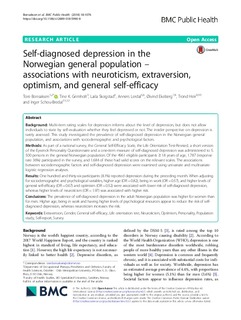Self-diagnosed depression in the Norwegian general population - associations with neuroticism, extraversion, optimism, and general self-efficacy
| dc.contributor.author | Bonsaksen, Tore | |
| dc.contributor.author | Grimholt, Tine K. | |
| dc.contributor.author | Skogstad, Laila | |
| dc.contributor.author | Lerdal, Anners | |
| dc.contributor.author | Ekeberg, Øivind | |
| dc.contributor.author | Heir, Trond | |
| dc.contributor.author | Schou-Bredal, Inger | |
| dc.date.accessioned | 2018-10-04T08:57:14Z | |
| dc.date.available | 2018-10-04T08:57:14Z | |
| dc.date.created | 2018-08-22T21:57:32Z | |
| dc.date.issued | 2018 | |
| dc.identifier.citation | BMC Public Health. 2018, 18:1076 | nb_NO |
| dc.identifier.issn | 1471-2458 | |
| dc.identifier.uri | http://hdl.handle.net/11250/2566343 | |
| dc.description.abstract | Multi-item rating scales for depression informs about the level of depression, but does not allowindividuals to state by self-evaluation whether they feel depressed or not. The insider perspective on depression is rarely assessed. This study investigated the prevalence of self-diagnosed depression in the Norwegian general population, and associations with sociodemographic and psychological factors. As part of a national survey, the General Self-Efficacy Scale, the Life Orientation Test-Revised, a short version of the Eysenck Personality Questionnaire and a one-item measure of self-diagnosed depression was administered to 5. 500 persons in the general Norwegian population. Of the 4961 eligible participants ≥ 18 years of age, 1.787 (response rate 36%) participated in the survey, and 1.684 of these had valid scores on the relevant scales. The associations between sociodemographic factors and self-diagnosed depression were examined using univariate and multivariate logistic regression analyses. One hundred and thirty-six participants (8.1%) reported depression during the preceding month. When adjusting for sociodemographic and psychological variables, higher age (OR = 0.82), being in work (OR = 0.57), and higher levels of general self-efficacy (OR = 0.67) and optimism (OR = 0.52) were associated with lower risk of self-diagnosed depression, whereas higher levels of neuroticism (OR = 1.97) was associated with higher risk. The prevalence of self-diagnosed depression in the adult Norwegian population was higher for women than for men. Higher age, being in work and having higher levels of psychological resources appear to reduce the risk of selfdiagnosed depression, whereas neuroticism increases the risk. | nb_NO |
| dc.language.iso | eng | nb_NO |
| dc.publisher | BioMed Central | nb_NO |
| dc.subject | extraversion | nb_NO |
| dc.subject | gender | nb_NO |
| dc.subject | general self-efficacy | nb_NO |
| dc.subject | life orientation test | nb_NO |
| dc.subject | neuroticism | nb_NO |
| dc.subject | optimism | nb_NO |
| dc.subject | personality | nb_NO |
| dc.subject | population study | nb_NO |
| dc.subject | self report | nb_NO |
| dc.subject | survey | nb_NO |
| dc.subject | ekstraversjon | |
| dc.subject | kjønn | |
| dc.subject | generell mestringstro | |
| dc.subject | nevrotisisme | |
| dc.subject | optimisme | |
| dc.subject | personlighet | |
| dc.subject | befolkningsstudie | |
| dc.subject | selvrapportering | |
| dc.title | Self-diagnosed depression in the Norwegian general population - associations with neuroticism, extraversion, optimism, and general self-efficacy | nb_NO |
| dc.type | Journal article | nb_NO |
| dc.type | Peer reviewed | nb_NO |
| dc.description.version | publishedVersion | nb_NO |
| dc.rights.holder | Open Access | nb_NO |
| dc.source.volume | 18 | nb_NO |
| dc.source.journal | BMC Public Health | nb_NO |
| dc.source.issue | 1076 | nb_NO |
| dc.identifier.doi | 10.1186/s12889-018-5990-8 | |
| dc.identifier.cristin | 1603896 | |
| cristin.unitcode | 251,3,0,0 | |
| cristin.unitname | Fakultet for helsefag | |
| cristin.ispublished | true | |
| cristin.fulltext | original | |
| cristin.qualitycode | 1 |
Files in this item
This item appears in the following Collection(s)
-
Artikler / Articles [1184]
-
Publikasjoner fra CRIStin [1110]
